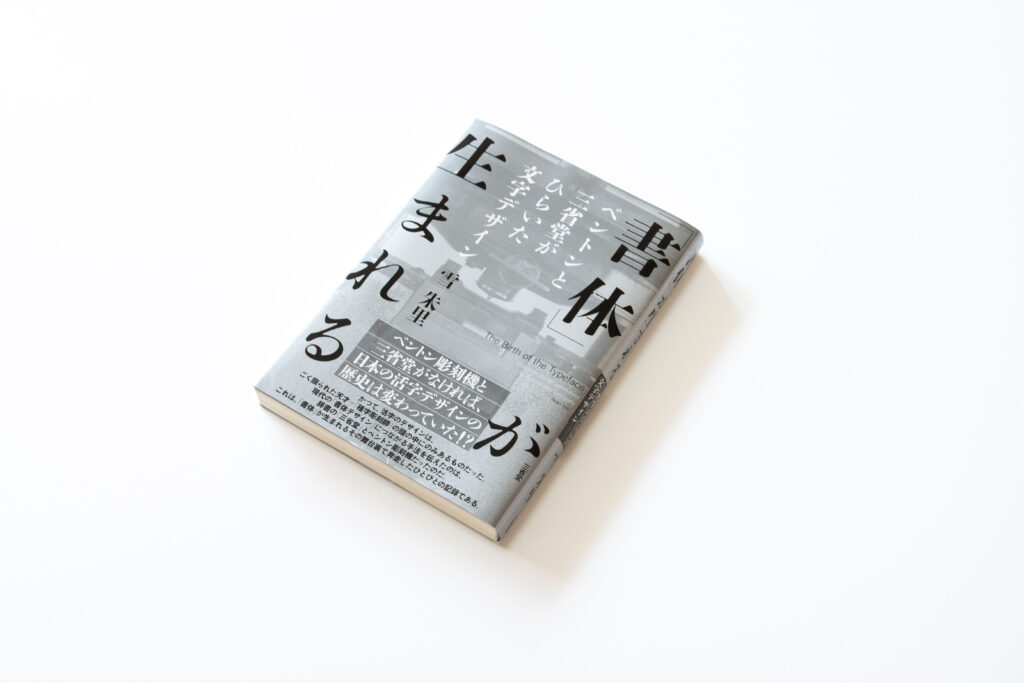Today, I would like to introduce “’Typeface’ is Created,” written by Akari Yuki.
In an online panel discussion for the commemoration of publication (https://www.hanmoto.com/yyevents/event-20211016), Isao Suzuki, representative of Type Project, served as an interview partner for the author.

The history of the “Benton Engraver,” which drastically changed the typeface design in metal type, and “Sanseido,” which triggered the implementation of the engraving machine in Japan, are described in this book.
Metal type used to be curved by an original type engraver in the past. The technique was extremely advanced, and original type engravers were limited in existence.
As the “Benton Engraver” enabled mechanical curving from the original drawing of lettering in paper, it improved efficiency of type creation and printing quality. It also opened up type design created only by original type engravers.
The “Benton Engraver” is the starting point of the currently general typeface design technique, which is to draw a character outline and create a typeface (font).
On the other hand, Tadakazu Kamei, founder of Sanseido, treasured the beauty of printing and even created the company’s own printing plant, based on his belief, “a good thing is always beautiful.”
Nevertheless, the fourth son of the founder, Torao Kamei, wasn’t satisfied with the standard at the time. As a result of his pursuit for further printing quality, he found the “Benton Engraver.”
From this fated event, Torao Kamei implemented the “Benton Engraver” in Sanseido after a lot of difficulties. This triggered the distribution of the “Benton Engraver” throughout Japan. This circumstance is described in great detail through the enormous amount of materials and number of interviews in this book.
Topics related to the Bézier curve have also appeared in the online panel discussion. Due to the Bézier curve, it became possible to draw beautiful curves without physical limitations. However, due to its mathematical properties, the actual operation requires a certain degree of experience. If there were a more natural and beautiful method of drawing than the Bézier curve, there would be a possibility of further evolution in typeface design – that’s what I thought about upon learning about the “Benton Engraver.”
Incidentally, Type Project is located in Shakujii, Nerima-ku; according to the book, one of the evacuation places of the “Benton Engraver” during the war was a theological school in Shakujii. I learned about an unexpected connection between Shakujii and typeface.
From the description of corrections made by the original type engraver to the matrix engraved by the Benton, the circumstance of effort made to handling the “Benton Engraver,” the details of the search for typeface design from scratch by conducting typeface research in each company that implemented the “Benton Engraver,” etc., I felt that in matching the eyes of people and technology for improvement, the machine is almighty and elaborate, and this remains the same in digital font creation.
Clear characters according to the features and limitations of tools after the “Benton Engraver,” and the difference of lines not created due to precision at the time of comparison with human-engraved characters are something I wasn’t aware of creating fonts in the current time.
I recommend this book also as a guide for learning about the important people and history that are the headwaters of Japan’s “typeface design.”
Book information:
“’Typeface’ is Created: Typeface Design Developed by Benton and Sanseido”
Author: Yuki Akari
Publisher: Sanseido
Purchase information:
Sanseido
https://dictionary.sanseido-publ.co.jp/dict/ssd34915
(LN and RK)
term
Series archive Recommended Book / Book of the Month
- Book of the Month (April 2025): “Table of Characters”
- Book of the Month (March 2025): “A Compilation of Contemporary Letter Designs”
- Book of the Month (November 2024): “There are Characters”
- Book of the Month (October 2024): “Man and Writing”
- Book of the Month (June 2024): “New Design Guide: Design of Japanese Language”
- Book of the Month (April 2024): “Mincho Type: Its Origin and Formation”
- Book of the Month (February 2024): “Stroll with Typography: Observation of Characters on the Road”
- Book of the Month (September 2023): “Shintaro Ajioka’s Typeface Course”
- Book of the Month (July 2023): “Men Who are Possessed by the Type”
- Book of the Month (February 2023) : “The Visual History of Type”
- Book of the Month (December 2022) : “Reading Letters”
- Book of the Month (October 2022): “SANS SERIF”
- Book of the Month (June 2022): “’Typeface’ is Created”
- Book of the Month (March 2022): “Size-specific adjustments to type designs”
- Book of the Month (December 2021): “The Field Guide to Typography: Typefaces in the Urban Landscape”
- Book of the Month (November 2021): “Designing Type”
- Book of the Month (October 2021): “Writing Vertically Creates the Scenery of Words – Why Do We Need Two Japanese Writings in Vertical and Horizontal?”
- Book of the Month (September 2021): “Kanji, Katakana, and Hiragana – History of Japanese Notation”
- Book of the Month (August 2021): “Scripts: Elegant Lettering from Design’s Golden Age”